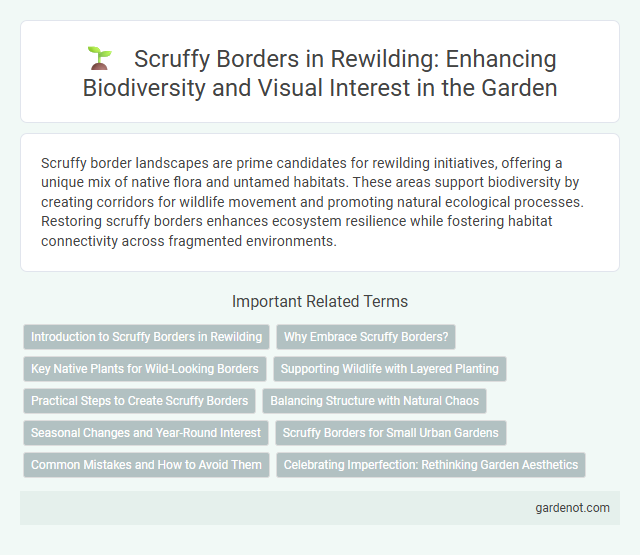Scruffy border landscapes are prime candidates for rewilding initiatives, offering a unique mix of native flora and untamed habitats. These areas support biodiversity by creating corridors for wildlife movement and promoting natural ecological processes. Restoring scruffy borders enhances ecosystem resilience while fostering habitat connectivity across fragmented environments.
Introduction to Scruffy Borders in Rewilding
Scruffy borders in rewilding refer to intentionally unmanaged or minimally maintained garden edges that promote biodiversity by providing habitats for pollinators, insects, and small wildlife. These borders include a mix of native wildflowers, grasses, and shrubs, creating ecological corridors that support natural food chains and improve soil health. Incorporating scruffy borders enhances urban and rural ecosystems by reconnecting fragmented habitats and fostering ecological resilience.
Why Embrace Scruffy Borders?
Scruffy borders enhance biodiversity by providing varied habitats for pollinators, birds, and small mammals often missing in manicured gardens. These untamed areas support native plant growth, improving ecosystem resilience and soil health. Embracing scruffy borders helps create natural corridors that promote wildlife movement and ecological balance.
Key Native Plants for Wild-Looking Borders
Scruffy borders benefit from key native plants like wild geranium, tufted hairgrass, and purple coneflower, which thrive in naturalistic settings and support local biodiversity. These species provide year-round texture and attract pollinators such as bees and butterflies, enhancing ecological balance. Integrating native shrubs like hawthorn or blackthorn adds structural diversity and habitat value to wild-looking garden edges.
Supporting Wildlife with Layered Planting
Scruffy borders enhance biodiversity by incorporating layered planting strategies that provide diverse habitats, food sources, and shelter for various wildlife species. Native shrubs, flowering perennials, and ground covers create vertical complexity, attracting pollinators, birds, and insects essential for ecological balance. Integrating multi-layered vegetation increases resilience against pests and climate stress, supporting sustainable rewilding efforts.
Practical Steps to Create Scruffy Borders
Creating scruffy borders involves integrating native plants, wildflowers, and grasses to encourage biodiversity and support local wildlife. Practical steps include reducing lawn areas, allowing natural growth, and avoiding chemical pesticides to foster a habitat for pollinators and small animals. Incorporating deadwood piles and varying plant heights enhances shelter and nesting opportunities within the scruffy border.
Balancing Structure with Natural Chaos
Scruffy borders enhance biodiversity by integrating wild plant growth with intentional landscaping, creating habitats for pollinators and small wildlife. Balancing structure with natural chaos involves selective planting alongside allowing spontaneous vegetation to flourish, maintaining aesthetic appeal while supporting ecological functions. This approach fosters resilient ecosystems, promotes soil health, and reduces maintenance efforts compared to conventional garden borders.
Seasonal Changes and Year-Round Interest
The Scruffy Border thrives with dynamic seasonal changes, showcasing vibrant blooms in spring and rich foliage textures through autumn. Its diverse plant selection ensures year-round interest, attracting pollinators and supporting local wildlife across all seasons. Maintenance focuses on promoting natural growth cycles that enhance habitat complexity and ecological resilience.
Scruffy Borders for Small Urban Gardens
Scruffy borders in small urban gardens create essential habitats for pollinators and beneficial insects, enhancing local biodiversity. Integrating native wildflowers and grasses encourages natural pest control and supports bird populations. These low-maintenance scruffy borders contribute to ecological connectivity, making even compact urban spaces valuable for rewilding efforts.
Common Mistakes and How to Avoid Them
Scruffy borders in rewilding efforts often arise from improper plant selection and neglecting local ecosystem dynamics, leading to invasive species overtaking native flora. Avoid common mistakes by choosing native plants that support local wildlife and establishing a maintenance schedule that mimics natural growth cycles. Monitoring soil health and ensuring diverse plant layers prevent unsightly overgrowth and enhance habitat resilience.
Celebrating Imperfection: Rethinking Garden Aesthetics
Scruffy borders embrace natural growth patterns, fostering biodiversity and supporting pollinators by providing diverse habitats. Allowing wildflowers and native plants to flourish enhances soil health and creates a visually dynamic, low-maintenance garden space. This approach challenges traditional manicured aesthetics, celebrating imperfection as a crucial element of ecological balance and sustainability.
Scruffy border Infographic

 gardenot.com
gardenot.com